Sustainable Aviation: Strategies for a Sustainable Future
VerifiedAdded on 2020/06/04
|9
|3232
|433
Essay
AI Summary
This essay provides a comprehensive overview of sustainable aviation, exploring the environmental and economic aspects of the industry. It examines the challenges posed by carbon emissions, noise pollution, and the use of fossil fuels, while also highlighting various solutions and strategies being implemented to mitigate these issues. The essay discusses the use of biofuels, the development of more fuel-efficient aircraft, and operational improvements aimed at reducing the environmental footprint of aviation. It also delves into the triple bottom line principle, emphasizing the importance of balancing social, economic, and environmental considerations. Furthermore, the essay addresses the difficulties and barriers to achieving sustainability in the aviation industry, including technological costs, lack of funding, and policy support. The essay concludes by emphasizing the need for a holistic approach to sustainable aviation that encompasses technological advancements, operational efficiency, and policy changes to ensure the long-term viability of the industry while minimizing its negative impacts on the environment and society.
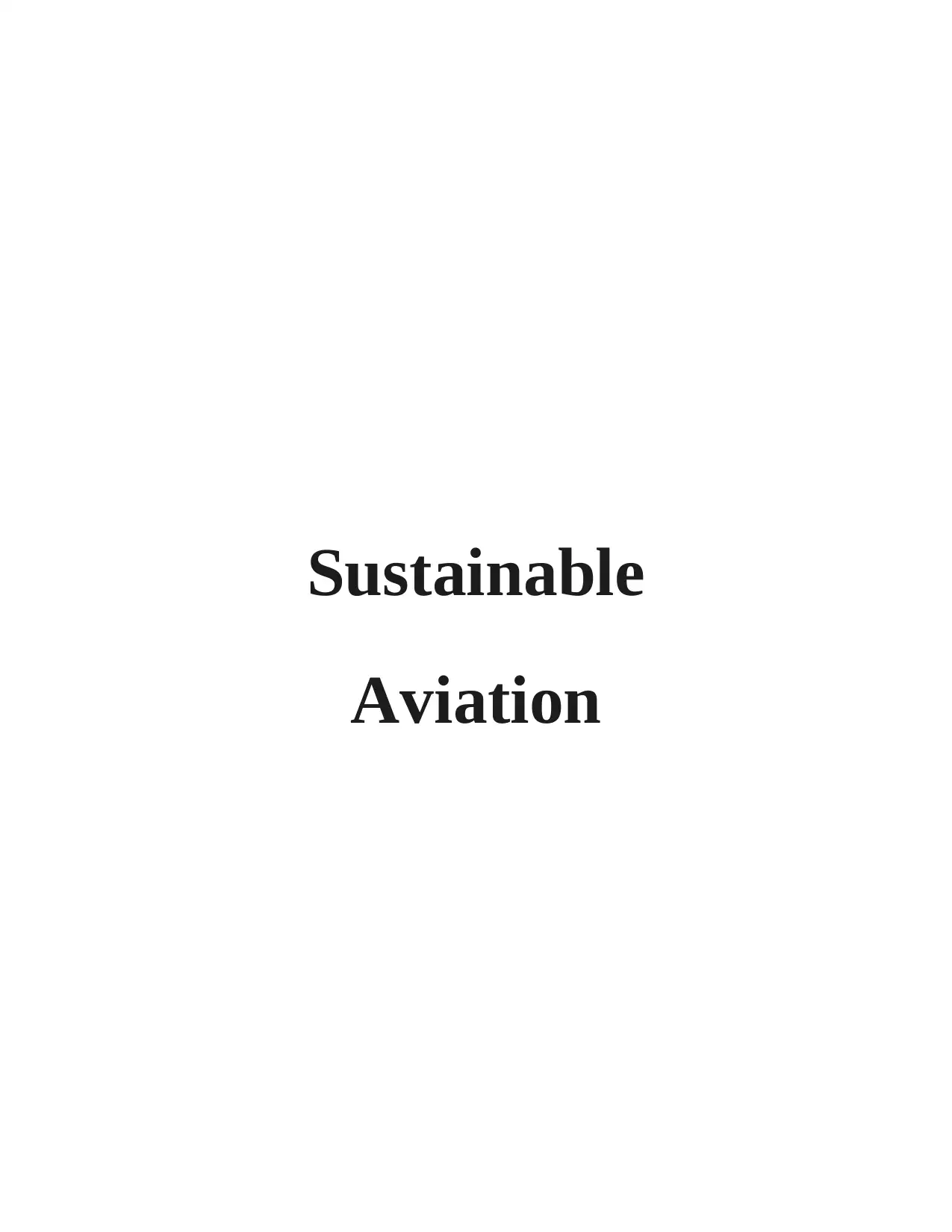
Sustainable
Aviation
Aviation
Paraphrase This Document
Need a fresh take? Get an instant paraphrase of this document with our AI Paraphraser
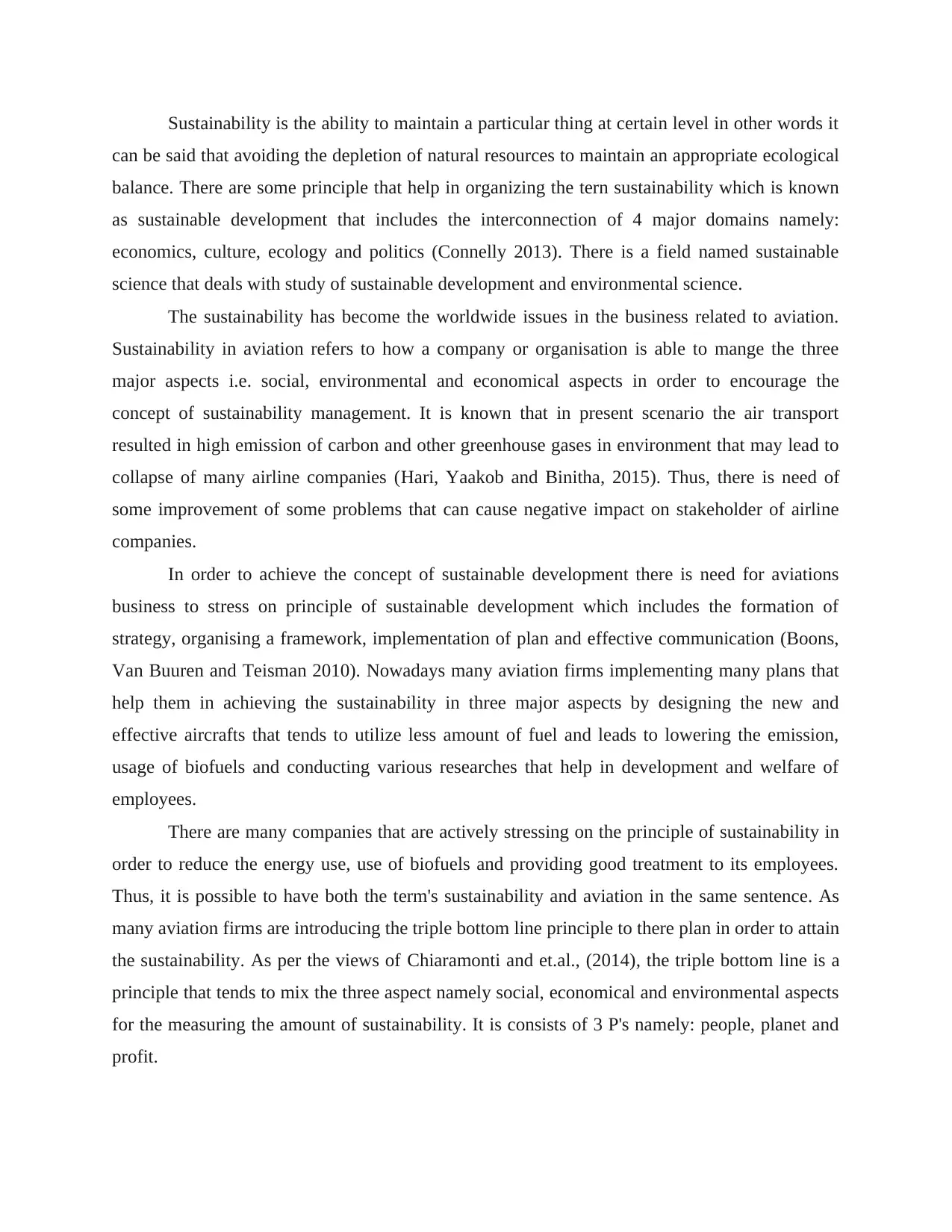
Sustainability is the ability to maintain a particular thing at certain level in other words it
can be said that avoiding the depletion of natural resources to maintain an appropriate ecological
balance. There are some principle that help in organizing the tern sustainability which is known
as sustainable development that includes the interconnection of 4 major domains namely:
economics, culture, ecology and politics (Connelly 2013). There is a field named sustainable
science that deals with study of sustainable development and environmental science.
The sustainability has become the worldwide issues in the business related to aviation.
Sustainability in aviation refers to how a company or organisation is able to mange the three
major aspects i.e. social, environmental and economical aspects in order to encourage the
concept of sustainability management. It is known that in present scenario the air transport
resulted in high emission of carbon and other greenhouse gases in environment that may lead to
collapse of many airline companies (Hari, Yaakob and Binitha, 2015). Thus, there is need of
some improvement of some problems that can cause negative impact on stakeholder of airline
companies.
In order to achieve the concept of sustainable development there is need for aviations
business to stress on principle of sustainable development which includes the formation of
strategy, organising a framework, implementation of plan and effective communication (Boons,
Van Buuren and Teisman 2010). Nowadays many aviation firms implementing many plans that
help them in achieving the sustainability in three major aspects by designing the new and
effective aircrafts that tends to utilize less amount of fuel and leads to lowering the emission,
usage of biofuels and conducting various researches that help in development and welfare of
employees.
There are many companies that are actively stressing on the principle of sustainability in
order to reduce the energy use, use of biofuels and providing good treatment to its employees.
Thus, it is possible to have both the term's sustainability and aviation in the same sentence. As
many aviation firms are introducing the triple bottom line principle to there plan in order to attain
the sustainability. As per the views of Chiaramonti and et.al., (2014), the triple bottom line is a
principle that tends to mix the three aspect namely social, economical and environmental aspects
for the measuring the amount of sustainability. It is consists of 3 P's namely: people, planet and
profit.
can be said that avoiding the depletion of natural resources to maintain an appropriate ecological
balance. There are some principle that help in organizing the tern sustainability which is known
as sustainable development that includes the interconnection of 4 major domains namely:
economics, culture, ecology and politics (Connelly 2013). There is a field named sustainable
science that deals with study of sustainable development and environmental science.
The sustainability has become the worldwide issues in the business related to aviation.
Sustainability in aviation refers to how a company or organisation is able to mange the three
major aspects i.e. social, environmental and economical aspects in order to encourage the
concept of sustainability management. It is known that in present scenario the air transport
resulted in high emission of carbon and other greenhouse gases in environment that may lead to
collapse of many airline companies (Hari, Yaakob and Binitha, 2015). Thus, there is need of
some improvement of some problems that can cause negative impact on stakeholder of airline
companies.
In order to achieve the concept of sustainable development there is need for aviations
business to stress on principle of sustainable development which includes the formation of
strategy, organising a framework, implementation of plan and effective communication (Boons,
Van Buuren and Teisman 2010). Nowadays many aviation firms implementing many plans that
help them in achieving the sustainability in three major aspects by designing the new and
effective aircrafts that tends to utilize less amount of fuel and leads to lowering the emission,
usage of biofuels and conducting various researches that help in development and welfare of
employees.
There are many companies that are actively stressing on the principle of sustainability in
order to reduce the energy use, use of biofuels and providing good treatment to its employees.
Thus, it is possible to have both the term's sustainability and aviation in the same sentence. As
many aviation firms are introducing the triple bottom line principle to there plan in order to attain
the sustainability. As per the views of Chiaramonti and et.al., (2014), the triple bottom line is a
principle that tends to mix the three aspect namely social, economical and environmental aspects
for the measuring the amount of sustainability. It is consists of 3 P's namely: people, planet and
profit.
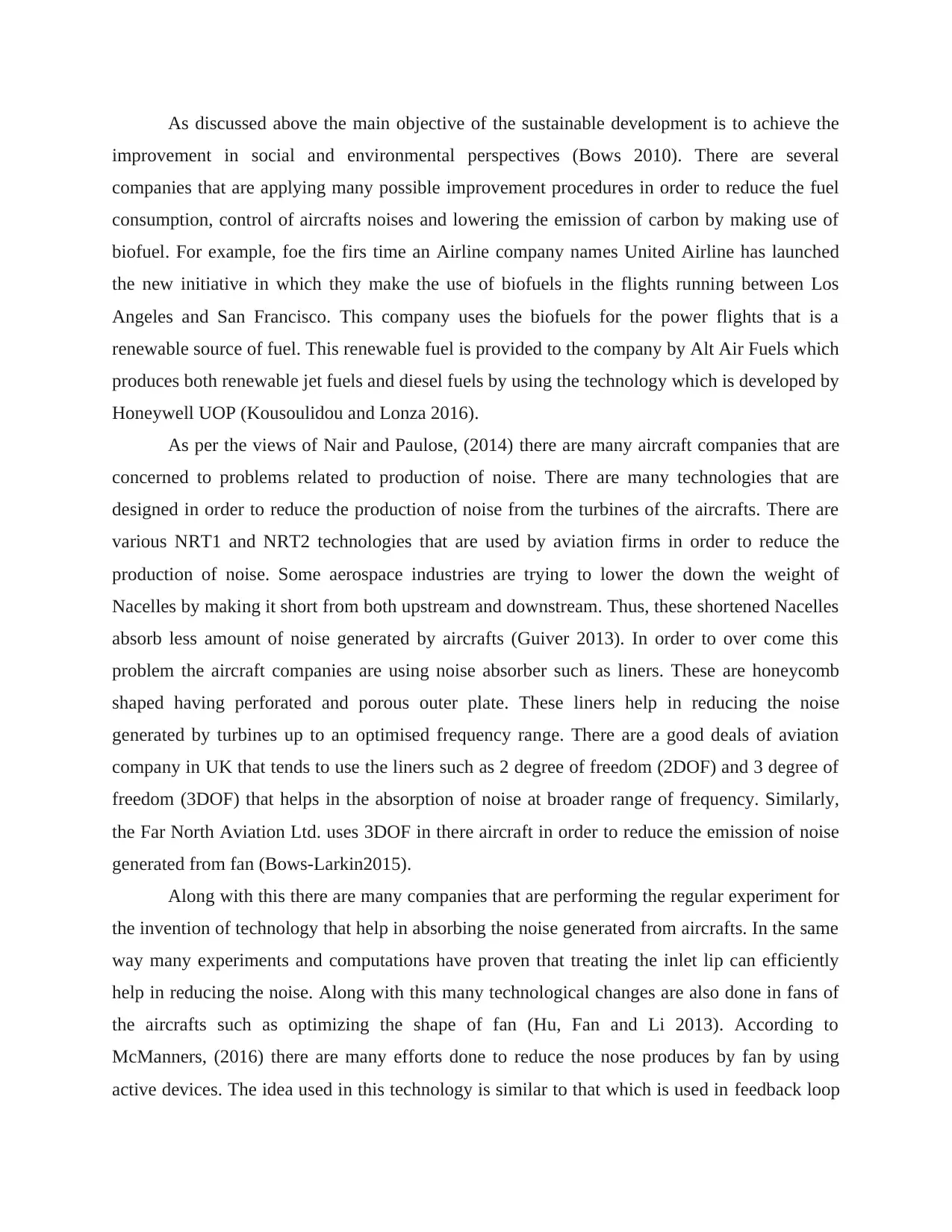
As discussed above the main objective of the sustainable development is to achieve the
improvement in social and environmental perspectives (Bows 2010). There are several
companies that are applying many possible improvement procedures in order to reduce the fuel
consumption, control of aircrafts noises and lowering the emission of carbon by making use of
biofuel. For example, foe the firs time an Airline company names United Airline has launched
the new initiative in which they make the use of biofuels in the flights running between Los
Angeles and San Francisco. This company uses the biofuels for the power flights that is a
renewable source of fuel. This renewable fuel is provided to the company by Alt Air Fuels which
produces both renewable jet fuels and diesel fuels by using the technology which is developed by
Honeywell UOP (Kousoulidou and Lonza 2016).
As per the views of Nair and Paulose, (2014) there are many aircraft companies that are
concerned to problems related to production of noise. There are many technologies that are
designed in order to reduce the production of noise from the turbines of the aircrafts. There are
various NRT1 and NRT2 technologies that are used by aviation firms in order to reduce the
production of noise. Some aerospace industries are trying to lower the down the weight of
Nacelles by making it short from both upstream and downstream. Thus, these shortened Nacelles
absorb less amount of noise generated by aircrafts (Guiver 2013). In order to over come this
problem the aircraft companies are using noise absorber such as liners. These are honeycomb
shaped having perforated and porous outer plate. These liners help in reducing the noise
generated by turbines up to an optimised frequency range. There are a good deals of aviation
company in UK that tends to use the liners such as 2 degree of freedom (2DOF) and 3 degree of
freedom (3DOF) that helps in the absorption of noise at broader range of frequency. Similarly,
the Far North Aviation Ltd. uses 3DOF in there aircraft in order to reduce the emission of noise
generated from fan (Bows-Larkin2015).
Along with this there are many companies that are performing the regular experiment for
the invention of technology that help in absorbing the noise generated from aircrafts. In the same
way many experiments and computations have proven that treating the inlet lip can efficiently
help in reducing the noise. Along with this many technological changes are also done in fans of
the aircrafts such as optimizing the shape of fan (Hu, Fan and Li 2013). According to
McManners, (2016) there are many efforts done to reduce the nose produces by fan by using
active devices. The idea used in this technology is similar to that which is used in feedback loop
improvement in social and environmental perspectives (Bows 2010). There are several
companies that are applying many possible improvement procedures in order to reduce the fuel
consumption, control of aircrafts noises and lowering the emission of carbon by making use of
biofuel. For example, foe the firs time an Airline company names United Airline has launched
the new initiative in which they make the use of biofuels in the flights running between Los
Angeles and San Francisco. This company uses the biofuels for the power flights that is a
renewable source of fuel. This renewable fuel is provided to the company by Alt Air Fuels which
produces both renewable jet fuels and diesel fuels by using the technology which is developed by
Honeywell UOP (Kousoulidou and Lonza 2016).
As per the views of Nair and Paulose, (2014) there are many aircraft companies that are
concerned to problems related to production of noise. There are many technologies that are
designed in order to reduce the production of noise from the turbines of the aircrafts. There are
various NRT1 and NRT2 technologies that are used by aviation firms in order to reduce the
production of noise. Some aerospace industries are trying to lower the down the weight of
Nacelles by making it short from both upstream and downstream. Thus, these shortened Nacelles
absorb less amount of noise generated by aircrafts (Guiver 2013). In order to over come this
problem the aircraft companies are using noise absorber such as liners. These are honeycomb
shaped having perforated and porous outer plate. These liners help in reducing the noise
generated by turbines up to an optimised frequency range. There are a good deals of aviation
company in UK that tends to use the liners such as 2 degree of freedom (2DOF) and 3 degree of
freedom (3DOF) that helps in the absorption of noise at broader range of frequency. Similarly,
the Far North Aviation Ltd. uses 3DOF in there aircraft in order to reduce the emission of noise
generated from fan (Bows-Larkin2015).
Along with this there are many companies that are performing the regular experiment for
the invention of technology that help in absorbing the noise generated from aircrafts. In the same
way many experiments and computations have proven that treating the inlet lip can efficiently
help in reducing the noise. Along with this many technological changes are also done in fans of
the aircrafts such as optimizing the shape of fan (Hu, Fan and Li 2013). According to
McManners, (2016) there are many efforts done to reduce the nose produces by fan by using
active devices. The idea used in this technology is similar to that which is used in feedback loop
⊘ This is a preview!⊘
Do you want full access?
Subscribe today to unlock all pages.

Trusted by 1+ million students worldwide
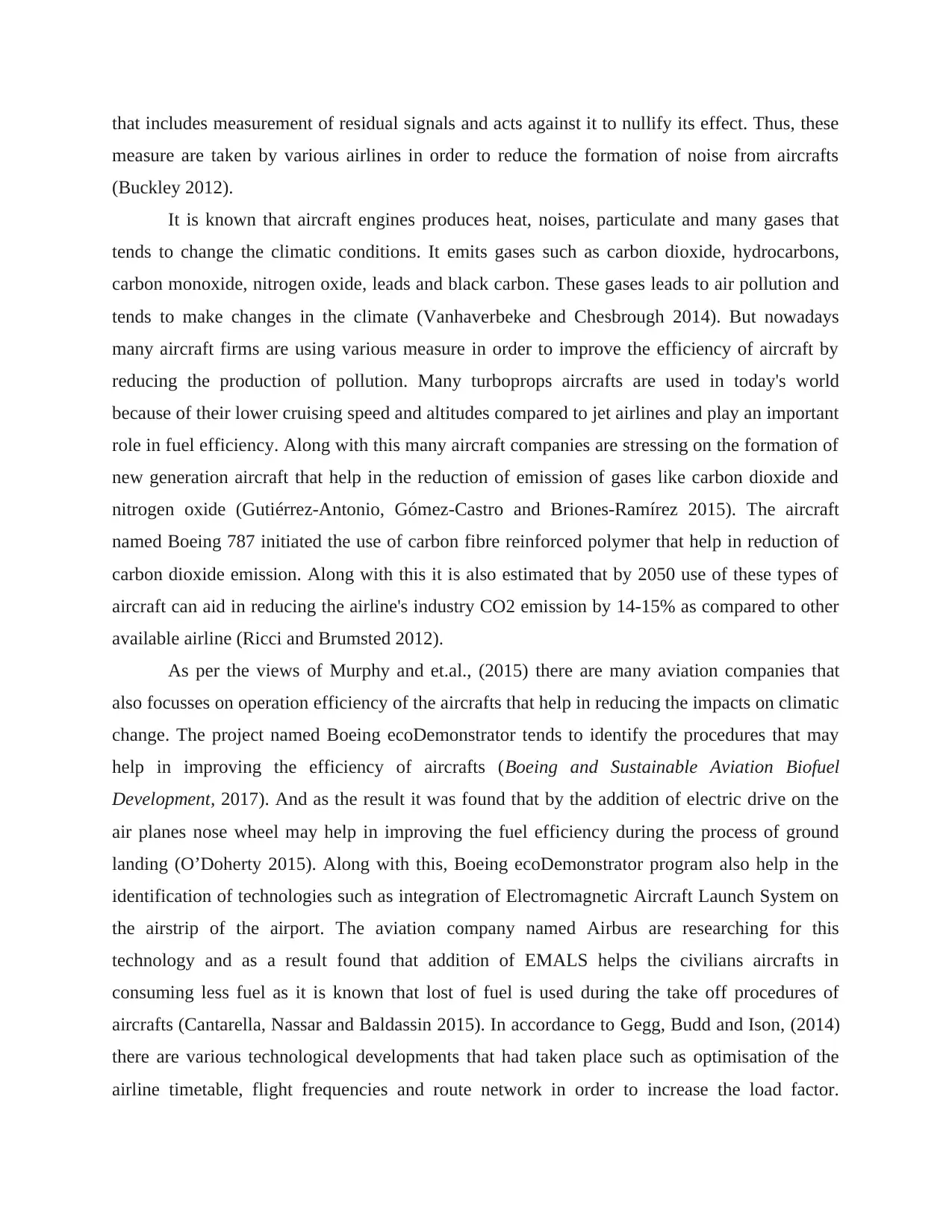
that includes measurement of residual signals and acts against it to nullify its effect. Thus, these
measure are taken by various airlines in order to reduce the formation of noise from aircrafts
(Buckley 2012).
It is known that aircraft engines produces heat, noises, particulate and many gases that
tends to change the climatic conditions. It emits gases such as carbon dioxide, hydrocarbons,
carbon monoxide, nitrogen oxide, leads and black carbon. These gases leads to air pollution and
tends to make changes in the climate (Vanhaverbeke and Chesbrough 2014). But nowadays
many aircraft firms are using various measure in order to improve the efficiency of aircraft by
reducing the production of pollution. Many turboprops aircrafts are used in today's world
because of their lower cruising speed and altitudes compared to jet airlines and play an important
role in fuel efficiency. Along with this many aircraft companies are stressing on the formation of
new generation aircraft that help in the reduction of emission of gases like carbon dioxide and
nitrogen oxide (Gutiérrez-Antonio, Gómez-Castro and Briones-Ramírez 2015). The aircraft
named Boeing 787 initiated the use of carbon fibre reinforced polymer that help in reduction of
carbon dioxide emission. Along with this it is also estimated that by 2050 use of these types of
aircraft can aid in reducing the airline's industry CO2 emission by 14-15% as compared to other
available airline (Ricci and Brumsted 2012).
As per the views of Murphy and et.al., (2015) there are many aviation companies that
also focusses on operation efficiency of the aircrafts that help in reducing the impacts on climatic
change. The project named Boeing ecoDemonstrator tends to identify the procedures that may
help in improving the efficiency of aircrafts (Boeing and Sustainable Aviation Biofuel
Development, 2017). And as the result it was found that by the addition of electric drive on the
air planes nose wheel may help in improving the fuel efficiency during the process of ground
landing (O’Doherty 2015). Along with this, Boeing ecoDemonstrator program also help in the
identification of technologies such as integration of Electromagnetic Aircraft Launch System on
the airstrip of the airport. The aviation company named Airbus are researching for this
technology and as a result found that addition of EMALS helps the civilians aircrafts in
consuming less fuel as it is known that lost of fuel is used during the take off procedures of
aircrafts (Cantarella, Nassar and Baldassin 2015). In accordance to Gegg, Budd and Ison, (2014)
there are various technological developments that had taken place such as optimisation of the
airline timetable, flight frequencies and route network in order to increase the load factor.
measure are taken by various airlines in order to reduce the formation of noise from aircrafts
(Buckley 2012).
It is known that aircraft engines produces heat, noises, particulate and many gases that
tends to change the climatic conditions. It emits gases such as carbon dioxide, hydrocarbons,
carbon monoxide, nitrogen oxide, leads and black carbon. These gases leads to air pollution and
tends to make changes in the climate (Vanhaverbeke and Chesbrough 2014). But nowadays
many aircraft firms are using various measure in order to improve the efficiency of aircraft by
reducing the production of pollution. Many turboprops aircrafts are used in today's world
because of their lower cruising speed and altitudes compared to jet airlines and play an important
role in fuel efficiency. Along with this many aircraft companies are stressing on the formation of
new generation aircraft that help in the reduction of emission of gases like carbon dioxide and
nitrogen oxide (Gutiérrez-Antonio, Gómez-Castro and Briones-Ramírez 2015). The aircraft
named Boeing 787 initiated the use of carbon fibre reinforced polymer that help in reduction of
carbon dioxide emission. Along with this it is also estimated that by 2050 use of these types of
aircraft can aid in reducing the airline's industry CO2 emission by 14-15% as compared to other
available airline (Ricci and Brumsted 2012).
As per the views of Murphy and et.al., (2015) there are many aviation companies that
also focusses on operation efficiency of the aircrafts that help in reducing the impacts on climatic
change. The project named Boeing ecoDemonstrator tends to identify the procedures that may
help in improving the efficiency of aircrafts (Boeing and Sustainable Aviation Biofuel
Development, 2017). And as the result it was found that by the addition of electric drive on the
air planes nose wheel may help in improving the fuel efficiency during the process of ground
landing (O’Doherty 2015). Along with this, Boeing ecoDemonstrator program also help in the
identification of technologies such as integration of Electromagnetic Aircraft Launch System on
the airstrip of the airport. The aviation company named Airbus are researching for this
technology and as a result found that addition of EMALS helps the civilians aircrafts in
consuming less fuel as it is known that lost of fuel is used during the take off procedures of
aircrafts (Cantarella, Nassar and Baldassin 2015). In accordance to Gegg, Budd and Ison, (2014)
there are various technological developments that had taken place such as optimisation of the
airline timetable, flight frequencies and route network in order to increase the load factor.
Paraphrase This Document
Need a fresh take? Get an instant paraphrase of this document with our AI Paraphraser

However, another important factor that help in reducing the climatic change is limiting the cruise
altitude of the aircrafts, which in turn help in the reduction of high altitude contrails for the
marginal trade-off (Chang, Chen and Hu 2015).
As per the views of Peeters and et.al., (2016) many scientists and aviation companies
such as GE Aviation and Virgin fuels are conducting researches on biofuel technology to
produce the fuel that can be used in jet airways. There are various aircrafts that are being using
the engines such as Wilksch WAM120 that can easily run on vegetable oil along with there are
number of engines invented that run efficiently on ethanol. In 2009 the Continental Airlines
completed the worlds first aviation tests using the sustainable Bio fuel. According to Cohen and
et.al., (2016) there is one biofuel named avgas which is being replaced by developing swift fuel.
This fuel was approved by ASTM international, that allow the company to continue there
ongoing research on the particular fuel.
Sustainable development is an oxymoron as the growth of aviation industry in UK and its
subsequent impacts on environment appear to be a debatable aspect. The white paper published
by UK government, there has been an increase in the air travel in UK by five times over the past
30 years. This has also been expected to rise over the coming three decades. Airport
development has been welcomed by some of the stakeholders but at the same time, others have
been concerned about its negative effects on climate change (Koblen, Szabo and Krnáčová
2013). The aviation industry has affected global climate change due to burning of fossil fuels in
large amounts in flights. Apart from that the environment has also suffered negative
consequences due to ground emissions from transport and consumption of energy in airport
buildings. Considerable response has been obtained from the aviation industry with respect to
sustainability (Weiszer, Chen and Locatelli, 2015). Sustainable aviation group and strategy is
being developed at an industry wide level. All the principal navigation service providers, airport
operators, aircraft manufacturers have set up these strategies regarding adopting sustainable
approaches. Hence, sustainable development requires the aviation industry to look after a number
of aspects such as noise, climate change, transport, local air quality etc.
While sustainable aviation requires strong commitment from the organizations, it is
difficult to achieve. Furthermore, it requires forgoing the economic benefits for protecting the
environment which would be a tough task for the aviation companies. The option to use biofuel
is met with the challenge of availability of suitable feedstock. Further, the definition of
altitude of the aircrafts, which in turn help in the reduction of high altitude contrails for the
marginal trade-off (Chang, Chen and Hu 2015).
As per the views of Peeters and et.al., (2016) many scientists and aviation companies
such as GE Aviation and Virgin fuels are conducting researches on biofuel technology to
produce the fuel that can be used in jet airways. There are various aircrafts that are being using
the engines such as Wilksch WAM120 that can easily run on vegetable oil along with there are
number of engines invented that run efficiently on ethanol. In 2009 the Continental Airlines
completed the worlds first aviation tests using the sustainable Bio fuel. According to Cohen and
et.al., (2016) there is one biofuel named avgas which is being replaced by developing swift fuel.
This fuel was approved by ASTM international, that allow the company to continue there
ongoing research on the particular fuel.
Sustainable development is an oxymoron as the growth of aviation industry in UK and its
subsequent impacts on environment appear to be a debatable aspect. The white paper published
by UK government, there has been an increase in the air travel in UK by five times over the past
30 years. This has also been expected to rise over the coming three decades. Airport
development has been welcomed by some of the stakeholders but at the same time, others have
been concerned about its negative effects on climate change (Koblen, Szabo and Krnáčová
2013). The aviation industry has affected global climate change due to burning of fossil fuels in
large amounts in flights. Apart from that the environment has also suffered negative
consequences due to ground emissions from transport and consumption of energy in airport
buildings. Considerable response has been obtained from the aviation industry with respect to
sustainability (Weiszer, Chen and Locatelli, 2015). Sustainable aviation group and strategy is
being developed at an industry wide level. All the principal navigation service providers, airport
operators, aircraft manufacturers have set up these strategies regarding adopting sustainable
approaches. Hence, sustainable development requires the aviation industry to look after a number
of aspects such as noise, climate change, transport, local air quality etc.
While sustainable aviation requires strong commitment from the organizations, it is
difficult to achieve. Furthermore, it requires forgoing the economic benefits for protecting the
environment which would be a tough task for the aviation companies. The option to use biofuel
is met with the challenge of availability of suitable feedstock. Further, the definition of

sustainability criteria is also uncertain which acts as a barrier in incorporating sustainability in
aviation industry. Adopting of sustainable options requires improvements in logistics which
proves to be costly for the organizations. Most importantly, lack of policy and political support
regarding aviation biofuel makes sustainable aviation an oxymoron.
There are several technological advances taking place that helps in the reduction of
carbon emission from the exhaust of the aircrafts but on the other hand these advancement's
comes with high cost. There are many aviation companies that are not able to implement these
modifications in their aircraft due to high cost. Along with these complications there are several
other factors that result in the inability of many aviation firms to utilize the available advance
technologies in order to attain the principle of sustainable development. These factors include
lack of funds and lack of knowledge among people working in particular aviation firms that
hinders them from using the new available technologies.
These complications lead the company to tackle many objection by aviation authority is
order to become fail to implement the principles of sustainable development in their firm
(Ibrahimoglu, Yilmazoglu and Cücen, 2016). This may lead to shutting down of the particular
organisation due to this failure. Along with this there are many aircraft that leads to emission of
pollutants in the air which causes change in the climate and lead to air pollution. Further this
climatic change highly affect the life of humans along with the increase in number of pollutants
particles in the air. Many respiratory and heart related disease occurs in humans by inhaling the
pollutant present in air.
From the above discussion it can be concluded that there are several procedures and steps
which are take by many aviation companies in order to reduce the emission of carbon dioxide
and other greenhouse gases that lead to air pollution and change in climate. Along with this
many technological advancements are done in the aviation industry that help in lowering the
noise generated from various parts of the aircraft. In addition to this many companies had also
developed the bio-fuel that help in reducing the emission of pollutants in the air to reduce the air
pollution. However, there are several political and social factor that limits the use of these bio-
fuel. Along with these the high cost of new technologies also hinders the aviation firms from
utilizing these technologies.
aviation industry. Adopting of sustainable options requires improvements in logistics which
proves to be costly for the organizations. Most importantly, lack of policy and political support
regarding aviation biofuel makes sustainable aviation an oxymoron.
There are several technological advances taking place that helps in the reduction of
carbon emission from the exhaust of the aircrafts but on the other hand these advancement's
comes with high cost. There are many aviation companies that are not able to implement these
modifications in their aircraft due to high cost. Along with these complications there are several
other factors that result in the inability of many aviation firms to utilize the available advance
technologies in order to attain the principle of sustainable development. These factors include
lack of funds and lack of knowledge among people working in particular aviation firms that
hinders them from using the new available technologies.
These complications lead the company to tackle many objection by aviation authority is
order to become fail to implement the principles of sustainable development in their firm
(Ibrahimoglu, Yilmazoglu and Cücen, 2016). This may lead to shutting down of the particular
organisation due to this failure. Along with this there are many aircraft that leads to emission of
pollutants in the air which causes change in the climate and lead to air pollution. Further this
climatic change highly affect the life of humans along with the increase in number of pollutants
particles in the air. Many respiratory and heart related disease occurs in humans by inhaling the
pollutant present in air.
From the above discussion it can be concluded that there are several procedures and steps
which are take by many aviation companies in order to reduce the emission of carbon dioxide
and other greenhouse gases that lead to air pollution and change in climate. Along with this
many technological advancements are done in the aviation industry that help in lowering the
noise generated from various parts of the aircraft. In addition to this many companies had also
developed the bio-fuel that help in reducing the emission of pollutants in the air to reduce the air
pollution. However, there are several political and social factor that limits the use of these bio-
fuel. Along with these the high cost of new technologies also hinders the aviation firms from
utilizing these technologies.
⊘ This is a preview!⊘
Do you want full access?
Subscribe today to unlock all pages.

Trusted by 1+ million students worldwide

REFERENCES
Books and journals
Boons, F., Van Buuren, A. and Teisman, G., 2010. November. Governance of sustainability at
airports: Moving beyond the debate between growth and noise. In Natural resources
forum. Blackwell Publishing Ltd. (Vol. 34, No. 4, pp. 303-313).
Bows-Larkin, A., 2015. All adrift: aviation, shipping, and climate change policy. Climate Policy.
15(6). pp.681-702.
Bows, A., 2010. Aviation and climate change: confronting the challenge. The Aeronautical
Journal. 114(1158). pp.459-468.
Buckley, R., 2012. Sustainable tourism: Research and reality. Annals of Tourism Research.
39(2). pp.528-546.
Cantarella, H., Nassar, A.M., and Baldassin, R., 2015. Potential feedstock for renewable aviation
fuel in Brazil. Environmental Development. 15. pp.52-63.
Chang, D.S., Chen and Hu, A.H., 2015. Identifying strategic factors of the implantation CSR in
the airline industry: The case of Asia-Pacific airlines. Sustainability. 7(6). pp.7762-
7783.
Chiaramonti, D. and et.al., 2014. Sustainable bio kerosene: Process routes and industrial
demonstration activities in aviation biofuels. Applied Energy. 136. pp.767-774.
Cohen, S. A. and et.al., 2016. Finding effective pathways to sustainable mobility: Bridging the
science–policy gap. Journal of Sustainable Tourism. 24(3). pp.317-334.
Connelly, J., 2013. Coalition, Aviation and the Descent to ‘Politics as Usual’. In Sustainable
Aviation Futures. Emerald Group Publishing Limited. (pp. 219-238).
Gegg, P., Budd, L. and Ison, S., 2014. The market development of aviation biofuel: Drivers and
constraints. Journal of Air Transport Management. 39. pp.34-40.
Guiver, J., 2013. Debate: Can sustainable tourism include flying?. Tourism management
perspectives, 6, pp.65-67.
Gutiérrez-Antonio, C., Gómez-Castro, F.I., and Briones-Ramírez, A., 2015. Intensification of a
hydrotreating process to produce biojet fuel using thermally coupled distillation.
Chemical Engineering and Processing: Process Intensification. 88. pp.29-36.
Books and journals
Boons, F., Van Buuren, A. and Teisman, G., 2010. November. Governance of sustainability at
airports: Moving beyond the debate between growth and noise. In Natural resources
forum. Blackwell Publishing Ltd. (Vol. 34, No. 4, pp. 303-313).
Bows-Larkin, A., 2015. All adrift: aviation, shipping, and climate change policy. Climate Policy.
15(6). pp.681-702.
Bows, A., 2010. Aviation and climate change: confronting the challenge. The Aeronautical
Journal. 114(1158). pp.459-468.
Buckley, R., 2012. Sustainable tourism: Research and reality. Annals of Tourism Research.
39(2). pp.528-546.
Cantarella, H., Nassar, A.M., and Baldassin, R., 2015. Potential feedstock for renewable aviation
fuel in Brazil. Environmental Development. 15. pp.52-63.
Chang, D.S., Chen and Hu, A.H., 2015. Identifying strategic factors of the implantation CSR in
the airline industry: The case of Asia-Pacific airlines. Sustainability. 7(6). pp.7762-
7783.
Chiaramonti, D. and et.al., 2014. Sustainable bio kerosene: Process routes and industrial
demonstration activities in aviation biofuels. Applied Energy. 136. pp.767-774.
Cohen, S. A. and et.al., 2016. Finding effective pathways to sustainable mobility: Bridging the
science–policy gap. Journal of Sustainable Tourism. 24(3). pp.317-334.
Connelly, J., 2013. Coalition, Aviation and the Descent to ‘Politics as Usual’. In Sustainable
Aviation Futures. Emerald Group Publishing Limited. (pp. 219-238).
Gegg, P., Budd, L. and Ison, S., 2014. The market development of aviation biofuel: Drivers and
constraints. Journal of Air Transport Management. 39. pp.34-40.
Guiver, J., 2013. Debate: Can sustainable tourism include flying?. Tourism management
perspectives, 6, pp.65-67.
Gutiérrez-Antonio, C., Gómez-Castro, F.I., and Briones-Ramírez, A., 2015. Intensification of a
hydrotreating process to produce biojet fuel using thermally coupled distillation.
Chemical Engineering and Processing: Process Intensification. 88. pp.29-36.
Paraphrase This Document
Need a fresh take? Get an instant paraphrase of this document with our AI Paraphraser
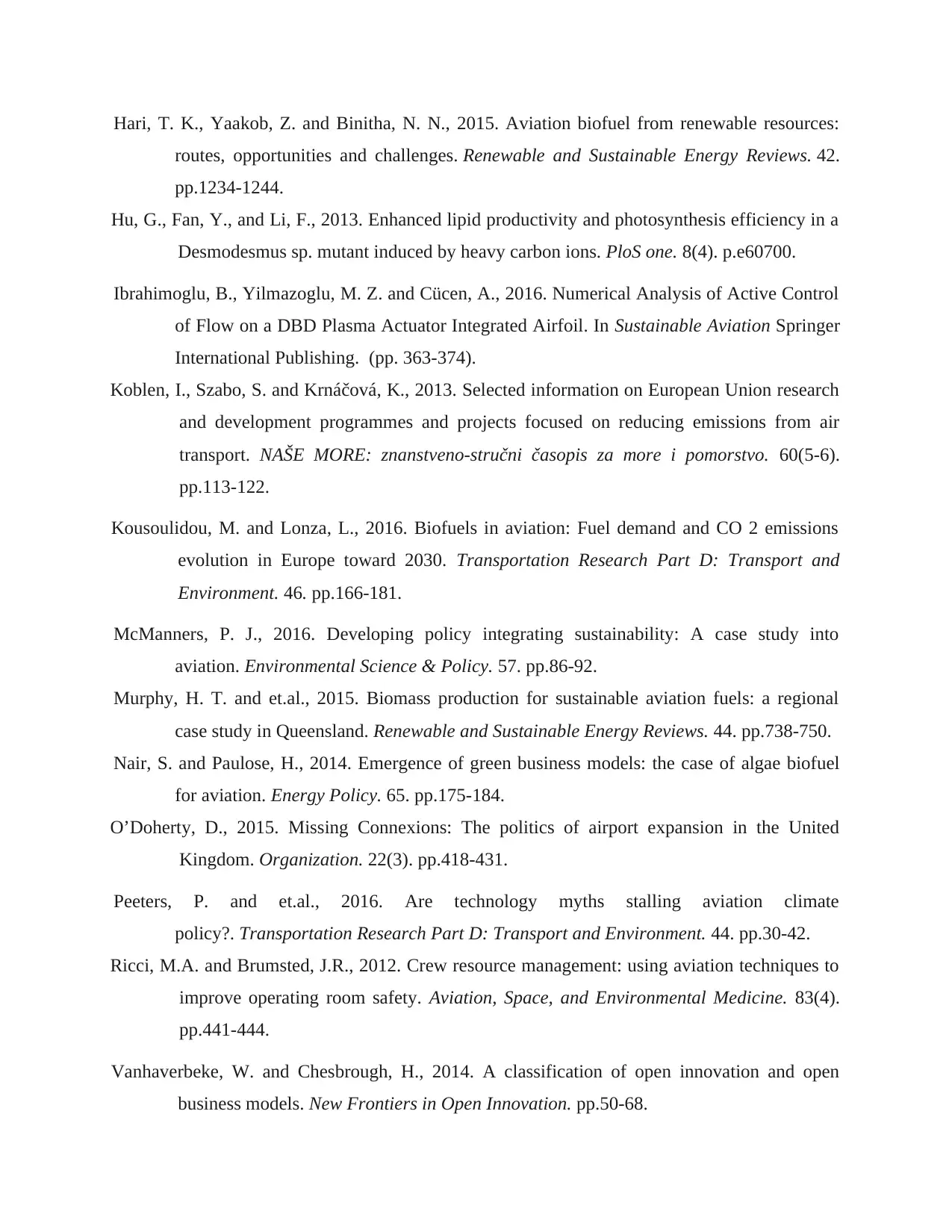
Hari, T. K., Yaakob, Z. and Binitha, N. N., 2015. Aviation biofuel from renewable resources:
routes, opportunities and challenges. Renewable and Sustainable Energy Reviews. 42.
pp.1234-1244.
Hu, G., Fan, Y., and Li, F., 2013. Enhanced lipid productivity and photosynthesis efficiency in a
Desmodesmus sp. mutant induced by heavy carbon ions. PloS one. 8(4). p.e60700.
Ibrahimoglu, B., Yilmazoglu, M. Z. and Cücen, A., 2016. Numerical Analysis of Active Control
of Flow on a DBD Plasma Actuator Integrated Airfoil. In Sustainable Aviation Springer
International Publishing. (pp. 363-374).
Koblen, I., Szabo, S. and Krnáčová, K., 2013. Selected information on European Union research
and development programmes and projects focused on reducing emissions from air
transport. NAŠE MORE: znanstveno-stručni časopis za more i pomorstvo. 60(5-6).
pp.113-122.
Kousoulidou, M. and Lonza, L., 2016. Biofuels in aviation: Fuel demand and CO 2 emissions
evolution in Europe toward 2030. Transportation Research Part D: Transport and
Environment. 46. pp.166-181.
McManners, P. J., 2016. Developing policy integrating sustainability: A case study into
aviation. Environmental Science & Policy. 57. pp.86-92.
Murphy, H. T. and et.al., 2015. Biomass production for sustainable aviation fuels: a regional
case study in Queensland. Renewable and Sustainable Energy Reviews. 44. pp.738-750.
Nair, S. and Paulose, H., 2014. Emergence of green business models: the case of algae biofuel
for aviation. Energy Policy. 65. pp.175-184.
O’Doherty, D., 2015. Missing Connexions: The politics of airport expansion in the United
Kingdom. Organization. 22(3). pp.418-431.
Peeters, P. and et.al., 2016. Are technology myths stalling aviation climate
policy?. Transportation Research Part D: Transport and Environment. 44. pp.30-42.
Ricci, M.A. and Brumsted, J.R., 2012. Crew resource management: using aviation techniques to
improve operating room safety. Aviation, Space, and Environmental Medicine. 83(4).
pp.441-444.
Vanhaverbeke, W. and Chesbrough, H., 2014. A classification of open innovation and open
business models. New Frontiers in Open Innovation. pp.50-68.
routes, opportunities and challenges. Renewable and Sustainable Energy Reviews. 42.
pp.1234-1244.
Hu, G., Fan, Y., and Li, F., 2013. Enhanced lipid productivity and photosynthesis efficiency in a
Desmodesmus sp. mutant induced by heavy carbon ions. PloS one. 8(4). p.e60700.
Ibrahimoglu, B., Yilmazoglu, M. Z. and Cücen, A., 2016. Numerical Analysis of Active Control
of Flow on a DBD Plasma Actuator Integrated Airfoil. In Sustainable Aviation Springer
International Publishing. (pp. 363-374).
Koblen, I., Szabo, S. and Krnáčová, K., 2013. Selected information on European Union research
and development programmes and projects focused on reducing emissions from air
transport. NAŠE MORE: znanstveno-stručni časopis za more i pomorstvo. 60(5-6).
pp.113-122.
Kousoulidou, M. and Lonza, L., 2016. Biofuels in aviation: Fuel demand and CO 2 emissions
evolution in Europe toward 2030. Transportation Research Part D: Transport and
Environment. 46. pp.166-181.
McManners, P. J., 2016. Developing policy integrating sustainability: A case study into
aviation. Environmental Science & Policy. 57. pp.86-92.
Murphy, H. T. and et.al., 2015. Biomass production for sustainable aviation fuels: a regional
case study in Queensland. Renewable and Sustainable Energy Reviews. 44. pp.738-750.
Nair, S. and Paulose, H., 2014. Emergence of green business models: the case of algae biofuel
for aviation. Energy Policy. 65. pp.175-184.
O’Doherty, D., 2015. Missing Connexions: The politics of airport expansion in the United
Kingdom. Organization. 22(3). pp.418-431.
Peeters, P. and et.al., 2016. Are technology myths stalling aviation climate
policy?. Transportation Research Part D: Transport and Environment. 44. pp.30-42.
Ricci, M.A. and Brumsted, J.R., 2012. Crew resource management: using aviation techniques to
improve operating room safety. Aviation, Space, and Environmental Medicine. 83(4).
pp.441-444.
Vanhaverbeke, W. and Chesbrough, H., 2014. A classification of open innovation and open
business models. New Frontiers in Open Innovation. pp.50-68.
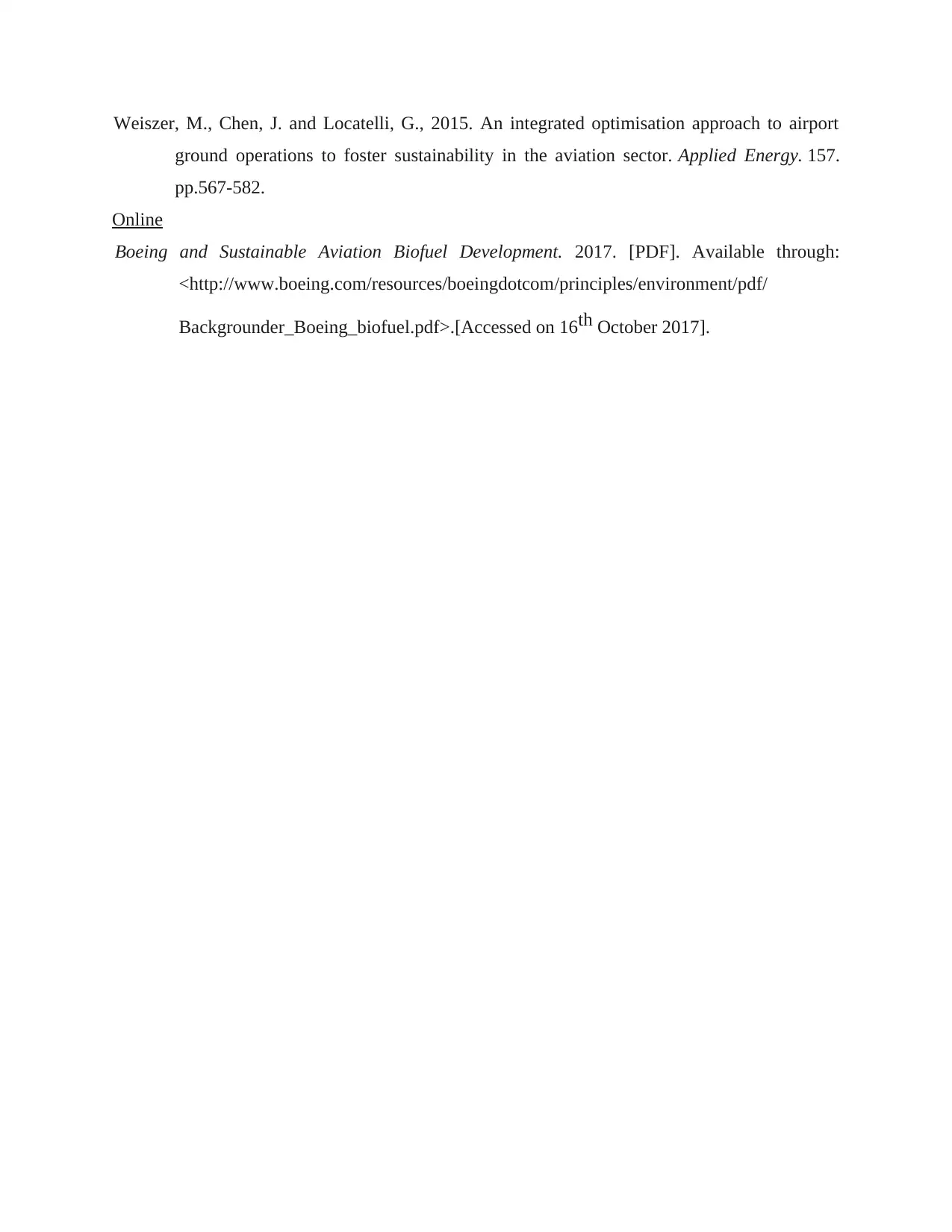
Weiszer, M., Chen, J. and Locatelli, G., 2015. An integrated optimisation approach to airport
ground operations to foster sustainability in the aviation sector. Applied Energy. 157.
pp.567-582.
Online
Boeing and Sustainable Aviation Biofuel Development. 2017. [PDF]. Available through:
<http://www.boeing.com/resources/boeingdotcom/principles/environment/pdf/
Backgrounder_Boeing_biofuel.pdf>.[Accessed on 16th October 2017].
ground operations to foster sustainability in the aviation sector. Applied Energy. 157.
pp.567-582.
Online
Boeing and Sustainable Aviation Biofuel Development. 2017. [PDF]. Available through:
<http://www.boeing.com/resources/boeingdotcom/principles/environment/pdf/
Backgrounder_Boeing_biofuel.pdf>.[Accessed on 16th October 2017].
⊘ This is a preview!⊘
Do you want full access?
Subscribe today to unlock all pages.

Trusted by 1+ million students worldwide
1 out of 9
Related Documents
Your All-in-One AI-Powered Toolkit for Academic Success.
+13062052269
info@desklib.com
Available 24*7 on WhatsApp / Email
![[object Object]](/_next/static/media/star-bottom.7253800d.svg)
Unlock your academic potential
Copyright © 2020–2026 A2Z Services. All Rights Reserved. Developed and managed by ZUCOL.





